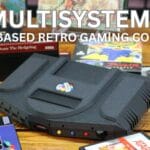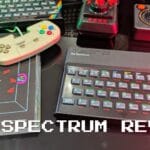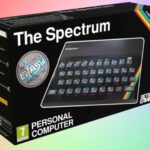Table of Contents
In this video I retro restore a Commodore 64C that I bought on eBay a month or two ago. It was described as not powering on, missing the power LED and for no reason why a hole was drilled where the power LED went. I find out the cause of it not powering it on. clean up the C64C including retrobrighting, replace the LED, add heatsinks and test all the ports with a Tape Cart SD, Pi1541 disk drive emulator and a Kung Fu Flash.
Commodore 64C Retro Restore Video
Parts used in this Commodore 64C Retro Restore video:
Replacement power LED and heatsinks – https://www.retroleum.co.uk/
Contact Cleaner – https://amzn.to/3jIbWoK
Isopropyl Alcohol – https://amzn.to/376iBUB
ESD Brushes Kit – https://amzn.to/3aX3YEc
CompuCleaner Air Duster – https://amzn.to/3qcu5xg
Jerome Russell Bblonde 40 Vol 12% Peroxide Cream 5ml – https://amzn.to/373P8dS
Onforu UV Strip Light – https://amzn.to/3jEGYxs
Commodore 64C Retro Restore (Text)
I got this C64C off ebay a few weeks ago and it was listed as not powering on. The seller had tried powering on with a working C64 power supply and nothing was happening. They did mention that the power LED was missing but this was not related as nothing was displaying on screen. It looks like the power led space has been drilled out to fit a round bulb instead of the flat bulb which was used in this model. No idea why 🙂
So let’s start by opening it up and check it for any visible damage.
This is a later model C64C which does away with screws holding the case together. Instead there are three clips on the bottom which can be pushed to release the case.
The top half of the case is connected to the bottom half via the keyboard cables, and normally the power LED which is missing on this one.
There’s seven screws holding the board to the case that need removing.
The board can now be lifted out and we can take a closer look.
The capacitors all look to be OK and not swollen or busted.
The fuse looks to be fine and not broken.
The power switch does look a bit gunked up. It’s not that uncommon for these to be the issue of not switching properly and causing it not to power up.
I will first try some contact cleaner on the switch and see if that removes any debris to make a better contact when switching on. I spray some in, let it work for a short while and then brush out any loose debris. Then I flick the switch plenty of times to loosen anything up. Then brush and blow it again.
I then check over the socketed chips to see if any are loose. They all seem to be secure.
I will give the board a quick spray with IPA and dust over with an anti static brush.
I want to see if the issue was the switch before doing anything else. So let’s get it connected up for a quick test.
Power on, and a quick wave from me for good luck, and it now powers on. It looks like it was a very easy fix!
Lets run the dead test cart via the Kung Fu Flash and see if there’s any issues.
I let it run for 15 minutes and there were no failures. The C64C will require further testing, but everything is looking good so far. Lets get on with the retro restore!
Starting with the case. The case is in OK condition. There is that drill hole where the flat LED goes but otherwise no major issues.
There’s a fair bit of yellowing all over, and just below the grill there is darker yellowing.
The bottom half of the case also has some yellowing but nothing retrobrighting can’t fix.
On to the keyboard. The keys are yellowed, naturally more at the top than the bottom. And under the keys I can see a nice layer of filth that will need to go. So I will get started on that.
As always, use a key puller when removing keys from old keyboards. It makes life much easier and in the case of a Commodore 64 keyboard, it reduces the chance of breaking the plungers
The space bar has a larger spring than the other keys so keep that separate from the others.
Cleaning the keys is easy. You just need some warm water, not too hot or you could melt the keys, and a squirt of fairy liquid. Chuck all the keys in and let them soak for 30 minutes or so. Here’s some ASMR for the fans 🙂
While they are soaking I can get on with cleaning the keyboard which is full of filth. I start by brushing off the loose debris with a brush.
You can see how much has come off already.
I then spray some IPA, let that work in for a bit and then brush off the majority of the gunk.
I then use some cotton pads to get in between the plungers for any stubborn dirt. As you can see there is quite a bit.
Now onto the case. Using some warm water and a sponge I go over all of the case to remove any surface dirt. The case itself is not that dirty, just a bit yellow. There’s a few scuffs here and there which I will leave alone as the case is not perfect looking due to the power LED hole.
I repeat the process for the bottom half of the case. And they are ready to retrobright.
Back to the keys which have been soaking for 45 minutes or so. The keys are now clean but you can see that comparing the top and bottom halves that they are still quite yellowed.
I won’t bore you with drying off the rest of the keys.
You can see my Atari ST video for the full retrobrighning process to save repeating it all again. For the keys I want to try dipping them in the peroxide instead of brushing the keys like I normally do. I am hoping this will give a more even and thicker coating.
It seems to be better dipping them, as I brushed one and can see it’s not covering as well or as thickly coated. So I will continue with dunking the keys 🙂
The cardboard is then wrapped with cling film and held in place with some tape. Then it’s off to the retro brighing box for several hours.
Several hours later, the keys are ready and they go back into some warm water to be rinsed off and dried. The keys are looking much better than before and to celebrate, here’s some more ASMR 🙂
And now on to the case. I pour the peroxide over and then kind of dab the brush rather than using strokes to not thin the cream too much. I am always trying to improve the process and I think this should also help get better results with a thicker layer of cream.
It’s then wrapped up in cling film and into the retro brighing box.
I repeat the process for the bottom half of the case. After each one is finished retrobrighting I simply rinse it off with some water. I didn’t bother filming that as it’s boring 🙂
So while the cases were in the box I carried on with the keyboard by putting all the keys back on.
I managed to put a key back in the wrong place so I had to remove it and tried without a key puller which I failed at. So yeah, just use a key puller 🙂
And double fail. I put the space bar back on the wrong way around 🙂
The keys are now looking great!
With that done, I can now move on to the board. I forgot to mention that there is some kind of green substance on the Cassette Tape edge connector. I thought at first it was a broken contact and showing the board underneath. But it is raised above the contacts. Then after taking this photo I noticed that there was some solder towards the bottom of the contact as well as some dodgy looking solder joints. Could it be a repair by a previous owner?
I was now thinking that it could be conductive ink? I have never tried it myself so not sure what it is like exactly but I think it could be this? Let me know in the comments any suggestions.
Anyway, I get on with cleaning the contacts up with some Contact Cleaner and a cotton bud.
For the mysterious green blob I wanted to scrape it down a bit so it is at least even with the contact. Using a scalpel, I scrape and cut a bit away to even it out. I will be testing this later and if there’s issues I think I will just flow some solder over the contact which should fix it.
I then continue with cleaning the rest of the contacts and all of the ports on the board.
For the moment, that is everything I can do, so let’s get it all put back together for some testing. I ordered a replacement power LED and some heatsinks to put on the SID, CPU and VIC chips which I will do after the testing.
Before fitting the power led to the case, let’s check it is working while I test everything else.
Powering on the C64C shows that the power led is working which is great news as I was wondering why it was missing and a hole drilled in the case. I guess we will never know 🙂
I will switch over to the capture card and test those user ports, starting with the cassette tape port which had the green blob. I am using a Tape Cart SD which is a cassette tape emulator loading software from a SD card.
It loads the browser program which is a good sign, and loading up a TCRT seems to be working great as well. I forgot to plug in a joystick but we can at least confirm that the port is working and there’s no damage that can’t be fixed.
Now onto the cartridge port. I know this is already working as I tried the dead test cart earlier but I will quickly try it with a game and a joystick plugged in. Chase HQ loads just fine and the joystick is working.
And now onto the disk drive port which I can test with my PI1541 disk drive emulator. It emulates a 1541 disk drive using a raspberry pi3. As it emulates the 1541 at hardware level, it also means it takes a bleedin age to load up 🙂 But yeah, the disk drive port is working just fine as well.
Now all the testing is done we can finish up with putting the heatsinks on. I forgot to mention that I got these and the LED from retroleum.co.uk/ who stock loads of spare parts for various retro computers. I ordered late in the afternoon and they got to me the next day, so I highly recommend checking them out if you need some parts at reasonable prices, not sponsored by the way/
The heatsink kit comes with instructions and a wipe to clean the chip surface before sticking the heatsinks on. Simply peel of the blue sticker and stick them on to the top of the respective chips. They are a little larger than the chips so you dont have to be dead on accurate.
And now back to the power LED. I am using hot glue to keep it held securely in place. I do have some different colour glue sticks, but the white one is a bit too bright and might look weird, so I decided against it and will use a clear one. It just needs a bit around the LED to keep it in place.
And I think that is everything done! Let’s take a quick look before and after. It was not powering on due to an issue with the power switch. The case was missing the power LED, it was yellowed, with it being more noticeable below the grill. And the keys were quite yellow as well.
Now we have a fully working C64C with a much nicer looking case and keyboard, and of course a LED 🙂




